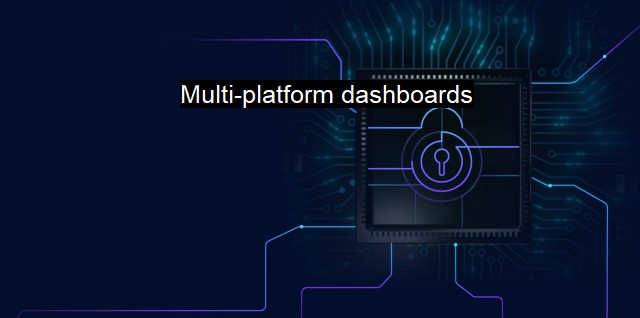What are Multi-platform dashboards?
The Power of Multi-Platform Cybersecurity Dashboards: Optimizing Endpoint Visibility, Rapid Response, and Threat Prevention
Multi-platform dashboards are dynamic tools that aggregate, organize, visualize, and analyze data from multiple different sources across several platforms. Particularly in the cybersecurity and antivirus realm, these dashboards can provide a vast amount of bespoke, real-time information on active threats, security performance, detected and resolved vulnerabilities, and other crucial cybersecurity interiors.In a world where cyber threats and attacks are recurrent, defending an organization's cyber infrastructure has become a crucial necessity. Cyber threats range from organized attacks by hacktivists, cybercriminals, and foreign governments to internal threats, not forgetting accidental breaches caused by organizational members. Taking these multi-layered cybersecurity threats into account, real-time monitoring and response have become integral. This is where multi-platform dashboards fit in.
Multi-platform cybersecurity dashboards collect data feeds from various cybersecurity technologies deployed across organizations' cyber infrastructure. This data may come from components like firewalls, antivirus software, intrusion detection and response systems, among others, effectively providing a comprehensive outlook of the organization's cybersecurity status. The collected data can then be visualized in many ways including charts, graphs, maps, and statistical forms, fostering an easily-understandable and clear overview of the cybersecurity landscape.
Multi-platform dashboards play an instrumental role in simplifying complex cybersecurity data. They take large sums of intricate data and turn them into clear, visually engaging, and simple-to-understand pieces of information. Thanks to this, even those without a profound technical understanding can grasp and comprehend cybersecurity statuses and updates. As such, these dashboards bridge the common comprehension barrier by rendering cybersecurity information accessible and easily navigable to all company stakeholders, from IT experts to non-technical staff members.
From a cybersecurity response perspective, multi-platform dashboards are pivotal. A real-time up-to-date dashboard addresses the eternal issue of time delay in mitigating threats. Ordinarily, the longer it takes to discover, address and mitigate an attack, the more harmful it could be to an organization. The dashboards, by providing real-time alerts and notifications about detected anomalies, ensure a quick reaction time, preventing or minimizing possible damage.
Data from antivirus software can be tracked on a dashboard to see virus detections' number and types across an organization's various systems. If the antivirus software, for instance, detects an excessive number of malware intrusions on a particular application, this can immediately be displayed on the platform. As such, IT security personnel can take quick actions, eliminating the threats and investigating the vulnerable points.
Multi-platform dashboards often come with customizable features, enabling organizations to tailor the platform to their specific needs. Therefore, irrelevant content can be filtered out, allowing for a focus on only the necessary, relevant data. This not only saves time but boosts efficiency in analyzing, interpreting and responding to data.
Beyond identifying threats and vulnerabilities, the multi-platform dashboards, coupled with advanced analytics capabilities, can facilitate predictive functions. By analyzing historic data, threat patterns can be recognized assisting in predicting and preventing possible future attacks before they transpire.
Lastly, these dashboards can support the compliance journey by keeping track of security controls and measures against the required cybersecurity standards while providing evidence of security adherence to auditors. This keeps organizations in the correct regulatory lane and encourages a commitment to a high security standard.
Multi-platform dashboards offer countless benefits in cyber threat detection, mitigation, response, reporting, and adherence to standards. As much as cybersecurity continues to become increasingly complex and multi-layered, the dashboards ease, simplify and streamline how organizations monitor and manage their security. This contributes vastly to enhancing and maintaining robust cybersecurity metrics down the line while safeguarding organizations from tangible losses resulting from cyber-attacks.

Multi-platform dashboards FAQs
What are multi-platform dashboards in relation to cybersecurity and antivirus?
Multi-platform dashboards are tools that enable the visualization of security and antivirus data from different systems and platforms in a single interface. This makes it easier to gain insights into security threats and vulnerabilities across various endpoints and devices.Why are multi-platform dashboards important for cybersecurity and antivirus?
Multi-platform dashboards are important for cybersecurity and antivirus because they allow security teams to monitor and analyze data from different sources in real-time. This helps in identifying suspicious activities and detecting threats early, which is crucial in preventing cyber attacks.What features should I look for in a multi-platform dashboard for cybersecurity and antivirus?
When selecting a multi-platform dashboard for cybersecurity and antivirus, it is essential to look for features such as real-time monitoring, custom dashboards, alerts and notifications, support for different platforms, and integration with other security tools.How can a multi-platform dashboard help my organization improve its cybersecurity and antivirus measures?
A multi-platform dashboard can help your organization improve its cybersecurity and antivirus measures by providing a centralized view of security data from different sources. This can help in identifying potential threats, prioritizing security incidents, and making data-driven decisions to improve your security posture. Additionally, a multi-platform dashboard can also streamline security operations, improve collaboration among security teams, and reduce time to resolution for security incidents.| | A | | | B | | | C | | | D | | | E | | | F | | | G | | | H | | | I | | | J | | | K | | | L | | | M | |
| | N | | | O | | | P | | | Q | | | R | | | S | | | T | | | U | | | V | | | W | | | X | | | Y | | | Z | |
| | 1 | | | 2 | | | 3 | | | 4 | | | 7 | | | 8 | | |||||||